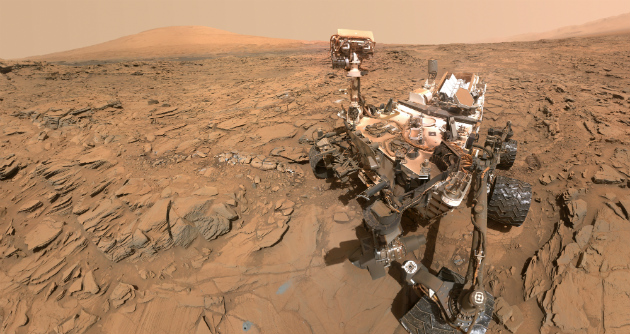www.CapTechU.edu

Photo: A self-portrait of NASA's Curiosity Mars rover. Credit: NASA/JPL-Caltech/MSSS
NASA recently announced the discovery of organic molecules – complex carbon particles – on Mars. Three years ago, Capitol students flew a high altitude balloon payload that found complex carbon particles in our upper atmosphere. We know Earth has life, but what if it didn't? If the Capitol balloon-borne TRAPSat experiment had been flown by remote aliens, could they have figured out if life existed on Earth?
The answer involves a little chemistry detective work.
The universe is full of carbon, hydrogen, nitrogen, oxygen – the elements of life. A chemist will tell you "organic molecules" just means “has carbon,” but in astrobiology it usually means something more significant. Either it's a find of methane (CH4) – a byproduct of life – or of complex carbon molecules that can lead to life, like amino acids. We've found amino acids in space dust, on comets, on asteroids. They arise naturally, but with the right combinations and added complexity, in theory you can eventually get all the way to DNA.
As a post on genomenewsnetwork.org explains, “both DNA and proteins are long molecules made from strings of shorter building blocks. While DNA is made of nucleotides, proteins are made of amino acids, a group of 20 different chemicals with names like alanine, arginine, and serine."
It's not a given that the presence of amino acids means 'life', but it's a good start. The 1950s Miller-Urey experiment showed that, given raw elements and lightning, naturally found elements can form into amino acids. Details can be found at Windows2Universe.org
In the warm primordial ocean, aggregates of amino acids, proteins, and other hydrocarbons came together into a form called coacervates.
Amino acids will spontaneously form coacervates in the same way that
beads of vinegar in oil come together. The Miller-Urey experiment showed
that amino acids form under conditions similar to the Earth's
primordial environment.
This suggests the basic “Lego bricks” of life can form in a variety of environments.
The presence of organic molecules doesn't in itself mean life, but it means life is possible. If you can't find organic molecules, there isn't life, so stop looking. However, if you do find organic molecules, then you have one of three situations. Either there is life (yay!), there once was life but it's gone and we just find its remains (boo!), or there's a possibility that life could arise (yay?). The discovery of organics on Mars puts us into all three possibilities, because there are a lot of organic materials found in the crust, and planet modeling suggests Mars may have once had enough water to support life.
This is where detective-style reasoning – and a little faith – come into the picture. Some argue that having the basic blocks that can lead to life isn't enough, that life forming is a one in a billion chance. In that case, it may be unlikely life formed on other planets or moons in our solar system. Others, though, favor the principle that “life finds a way” (we could call this the Jurassic Park approach). They point out that life is ridiculously tenacious and exists even on Earth in environments where it shouldn't – near volcanoes, in frozen areas, near deep sea steam vents.
I like to call these the “recipe” vs the “ingredients” stances – do you need a fancy kitchen and recipes to make food (“life arises rarely”), or can you create a decent meal given enough ingredients even without a lot of structure (“life is tenacious”)?
Finding organics on Mars isn't evidence of life on Mars, but it tilts us more favorably towards the prospect that life did or may still exist on Mars, and thus makes it worth searching deeper. It would be the same for the what-if I proposed: if aliens did a TRAPSat-like experiment on Earth and found organics, could they prove life existed from that experiment? No, but it would support the possibility of life, and give justification to looking deeper. While no evidence can mean either “dig deeper” or “move to a new target,” once you have evidence, there's still work to do. When NASA or Capitol or any experiment finds evidence, like a good detective that means it's time to dig deeper.
Best of all, the way to dig deeper is to come up with better experiments using better equipment. When science people say “we need new data,” to me this means they need new engineers to make new systems to get new data. And that’s where Capitol comes in. Whether it’s data forensics, as taught in our cyber program, or the sensor tech used in our EE/AE programs, our students are gaining the tools and skill sets they need to advance knowledge.
Science is a motivator for technological improvement, and the results of new developments in science and engineering end up spilling over to general American life (see: weather forecasts, microtechnology – oh, and the internet). So really, the more we look for life, the more we improve life on Earth. So yay for Mars, and yay for Earth, we know one of you has life and looking for life on the other is going to be awesome!

Professor, Astronautical Engineering
No comments:
Post a Comment